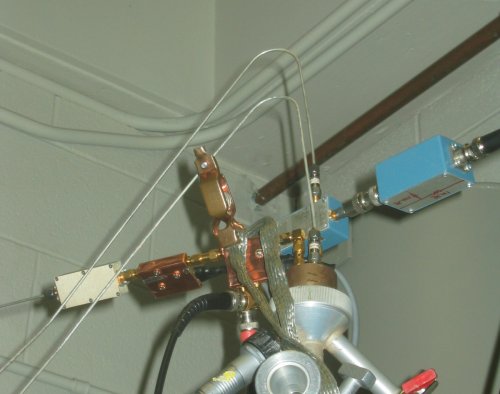Time Domain Capacitance Spectroscopy
TDCS is a high resolution spectroscopic technique that opens a new dimension, energy from the Fermi surface, to systematic measurement and exploration. We gain unique insight into the contribution of interactions to the physics of 2D systems by starting with an empty quantum well and examining how the quasiparticle spectrum changes as a continuous function of carrier density.
Tunneling measurements provide remarkable insight in many body physics; the relatively simple quantity dI/dV provides access to the single particle density of states (SPDOS), a quantity integral to our theoretical understanding of many-body systems. Two-dimensional systems, host to remarkable correlated phenomena such as the fractional and integer quantum Hall effects, have proven difficult to probe using tunneling spectroscopy because of difficulties including ohmic heating and low in-plane conductivities. We have developed an improved version of time domain capacitance spectroscopy (TDCS) that overcomes all of these difficulties. Using it, we probe the integer quantum Hall effect in a GaAs 2DES, directly observing exchange splittings and quasiparticle lifetimes. These measurements reveal the difficult to reach and beautiful structure present in this highly correlated system far from the Fermi surface.
Tricks
This experiment is technically demanding; large bandwidth signals (from around 1 kHz to 1 GHz) need to be generated with exquisite precision, transmitted deep inside of a helium dilution refrigerator (without too much heating!), and applied to our sample. However, that’s only half the trip! Once we’ve balanced two large signals against each other, we’re left with a tiny trickle of charge which we need to amplify and transmit back out of the cryostat to room temperature.
Here are a few specific examples of the kinds of considerations that go into making this experiment work.
Although this looks like a 3D map of a highway interchange, it’s actually the interior of our “pulse shaper”. This home-built device takes electrical pulses generated by commercial pulse generators, which typically “ring,” or wiggle around, and turns them into the nearly perfectly flat pulses we need for this experiment.
The thick, silver colored wires that you see arcing around the inside of the box (which is normally sealed!) carry the high-frequency pulses to the circuit boards that do the actual magic. These high frequency pulses don’t like to turn around sharp corners, so we use these gentle curves instead.
Here, you can see the place where some of our wiring enters the cryostat. Notice the smooth curves once again in the thick, silver colored wires (they’re called semi-rigid coaxial cables) as they enter. The white-banded cylinders they’re attached to at the top of the stick are called attenuators; they make signals smaller. Not only do they help us by making the noise generated by our signal generators less important, but they help with reflections. We cannot afford to absorb the radio-frequency pulses we send down into our cryostat; the energy involved would heat up our fridge. Instead, we let most of the power reflect back out of the cryostat. Normally this would be a problem, because some of that power would reflect back off our signal generator (it isn’t perfect), and we’d see it hit our sample again in about twice the time it takes light to travel down the length of our cables. That’s a long time in our experiment; we need to have completed our entire measurement in about 100 nanoseconds, around the amount of time it takes light to travel to first base from home plate on a baseball field. However, each time the signal travels through the attenuator, it’s made smaller; this reflection has passed through these attenuators two extra times on the way back to the sample, so it’s small enough we can ignore it.

